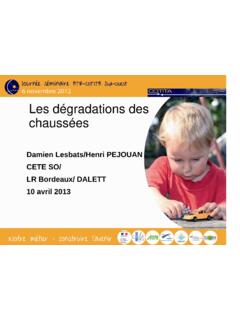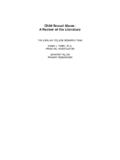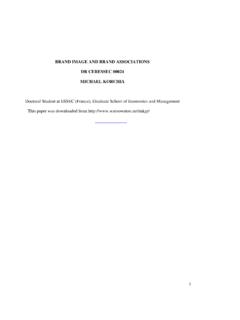Transcription of A Social Analysis of Religious Organisations: The …
1 Sl m Ara t rmalar Dergisi, Say 13, 2005, 63-108. A Social Analysis of Religious Organisations: The Cases of Church, Sect, Denomination, Cult and New Religious Movements (NRMs) and Their Typologies Nuri T naz . This paper examines the sociological concepts and Analysis of Religious or- ganisations; church, sect, cult, denomination and new Religious move- ments. It also aims to bring together all sociological arguments of Religious organisations to show how they have developed, evolved and then trans- formed over the years, and how their Analysis and understanding have changed and differed from one sociologist to another over the time.
2 The sudden rise of cult and new Religious movements has accelerated concep- tual complexity and confusion in the sociology of religion when analyzing and studying religion, Religious organisations and movements, so that so- ciologists have felt obliged to create new typologies to understand and in- terpret the changing face of Religious phenomena. Keywords: Sociology of Religion, Church-Sect Typology, Cult, Denominati- on, New Religious Movement (NRM) Typologies. Social scientists have sought to offer interpretations of Religious organisa- tions, movements and ferments at the same time as dealing with and taking interest in their diversity.
3 They have attempted to create types and categories that can be linked theoretically to explanations for these diverse forms of organisations, movements, beliefs and Religious ideologies. A substantial number of typologies, types and categories have been formulated based on different teachings, objectives, perspectives, meaning systems, forms of organisations, both internal and external follower- organisation relations, ori- entations towards the world, and relations with society at large. From its early stage, the sociology of religion, as part of Social sciences, has been preoccupied with the sociological and Religious conceptual complex- Dr.
4 , Center for Islamic Studies ( SAM), Istanbul; Dept. of Sociology, SPS, University of Cambridge, UK. SAM, stanbul 2005. sl m Ara t rmalar Dergisi ities of Religious organisations and movements, like church, sect and cult. As Bryan Wilson properly pointed out the sociology of religion is a field in which sociological thinking and Religious thinking are not always clearly distin- guished. The interest that theologians take in this special field and the edu- cation they have received are likely to perpetuate the use of specific cate- gories that are indifferent to sociologically significant distinctions.
5 This is not to say that the contributions of theologians to this field are insignificant. Sometimes they have provided valuable insight; but more often, they have introduced elements of On the other hand, the contributions to the field from different perspec- tives and disciplines have enriched and developed themes, perspectives and problems in the sociology of religion. Consequently, the sociology of religion has gained a distinctive position in the Social sciences in general, and in soci- ology in particular, by embracing almost all aspects of the Social life of reli- gious phenomenon.
6 Sociological concepts may be generally defined by identifying Social phe- nomena. But their meaning differs from researcher to researcher. This is when the need arises to go back to the original sources of sociological analy- sis, as the original meaning, definition and usage of concepts may help to understand the present use of sociological terms in The main aim of this paper is to examine the development of sociological concepts of reli- gious organisations like church, sect, cult, denomination and New Religious Movements (NRMs), and to show how their Analysis and understandings by the sociologists differ according to time, period and context.
7 The other pur- pose of this paper is to bring together all sociological arguments of Religious organisations to show how they have developed and evolved over the years and how they differ from one sociologist to another. This paper is divided into three parts. In the first part, the early period', I will analyse the early argu- ments of church-sect typologies created by sociologists like Weber, Troeltsch and Niebuhr. The second part, which is concerned with the transitional peri- od', will take into account the different categories of sect typologies, church- sect dichotomy, denomination and cults.
8 In this section, I will try to highlight 1 Bryan R. Wilson, Typologie des sects dans une perspective dynamique et comparative , Archives de Sociologie des Religions, 16 (1963), 49-63. 2 Theodore M. Steeman, Church, Sect, Mysticism, Denomination: Periodological Aspects of Troeltsch's Types , Sociological Analysis , 36/3 (1975), 181-204. 64. A Social Analysis of Religious Organisations how understandings and interpretations of those concepts have changed and differed, as in the arguments of Yinger, Wilson and Martin. The third part, the modern period', will try to demonstrate how sect-cult debates in the transi- tional period' paved the way and influenced the development of sect, cult and NRMs arguments and their transformations.
9 This last section will also cover the major attempts of sociologists to create typologies of NRM and Cults, such as Robbins and Anthony, Wallis, Bird, Stark and Bainbridge, and Beckford. The paper ends with a general discussion and conclusion. I. The Early Period Although there is a long history of church-sect polarity arguments in the writings of church historians, the initial Analysis , from a sociological perspec- tive, belongs to Max Weber. The first sociological analyses and conceptual typologies, however, were made by Weber's former student and colleague Ernst Troeltsch.
10 From the outset, church-sect theorising manifested itself as the Troeltschians Syndrome' in later sociological studies of Religious organi- sations. This demonstrates how the interests in analyses and typologies of Religious organisations moved rapidly away from Weber's study towards Troeltsch's Church-Sect Dichotomy In Weber's sociological account of church and sect, the nature of church is connected to his general typology of political institutions, , institutions that are capable of exercising authority. He argues that A hierocratic organisation is a political association which enforces its order through psychic coercion by distributing or denying Religious benefits (hie- rocratic coercion).





